Interesting Collection of Photos Collected From History
Nathan Johnson
Published
10/06/2016
in
wow
you might learn something
- List View
- Player View
- Grid View
Advertisement
-
1.
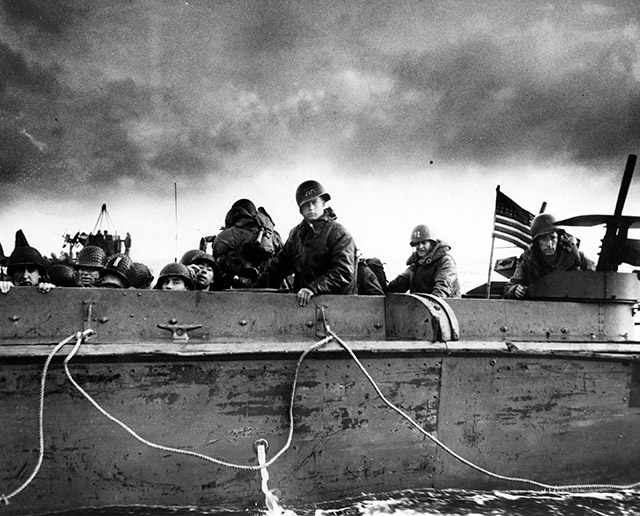 Troops and crewmen aboard a Coast Guard manned LCVP get ready to storm the Normandy beaches. June 6th, 1944
Troops and crewmen aboard a Coast Guard manned LCVP get ready to storm the Normandy beaches. June 6th, 1944 -
2.
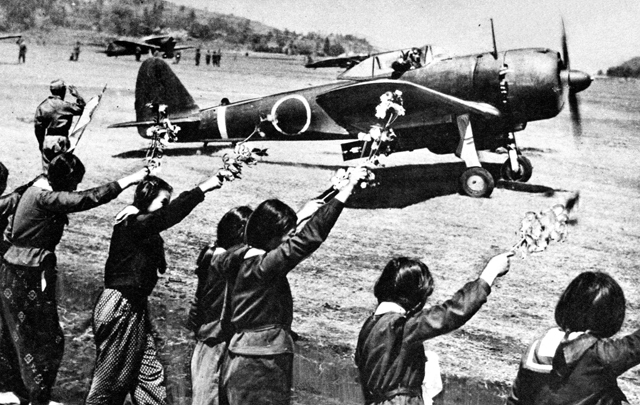 High school girls wave kamikaze pilot taking off, WW2, 12 april 1945
High school girls wave kamikaze pilot taking off, WW2, 12 april 1945 -
3.
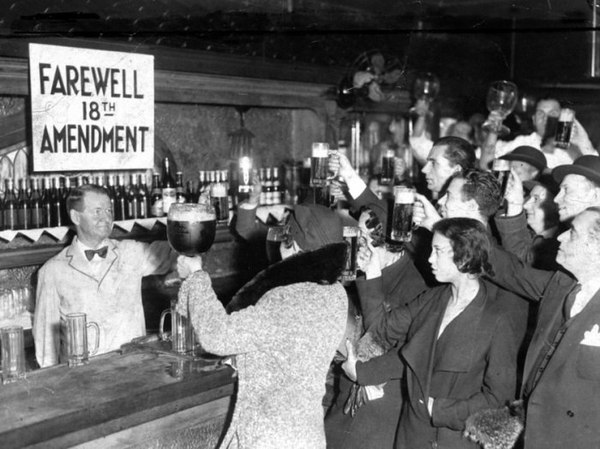 December 5, 1933: The day when nationwide alcohol ban was repealed
December 5, 1933: The day when nationwide alcohol ban was repealed -
4.
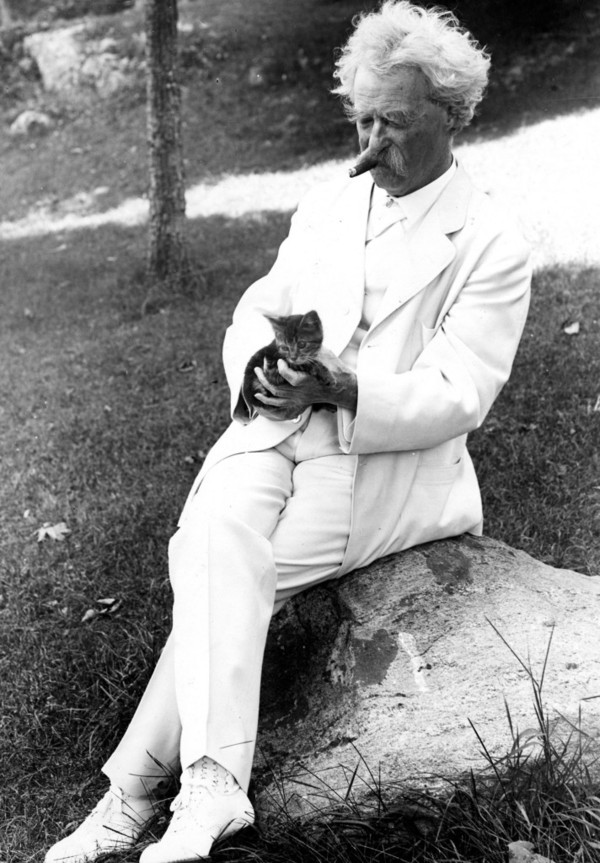 Mark Twain and kitten in NYC in 1907
Mark Twain and kitten in NYC in 1907 -
5.
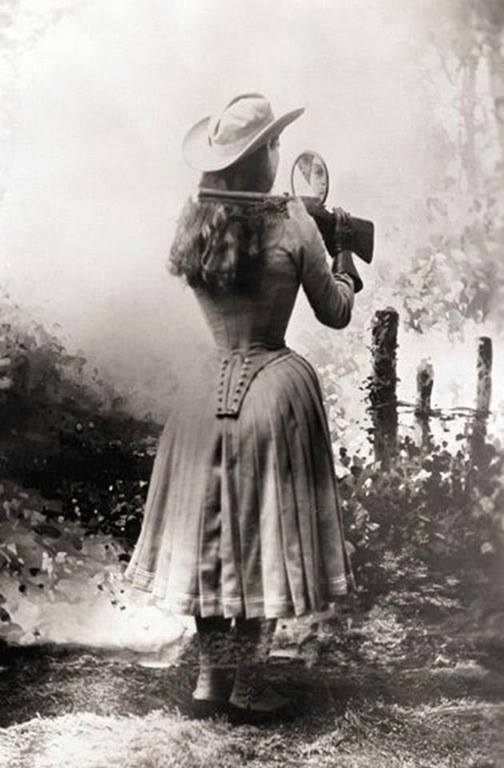 Annie Oakley shooting over her shoulder using a hand mirror, 1888
Annie Oakley shooting over her shoulder using a hand mirror, 1888 -
6.
 Senator John F. Kennedy and Jacqueline Bouvier Kennedy on their wedding day. September 12, 1953
Senator John F. Kennedy and Jacqueline Bouvier Kennedy on their wedding day. September 12, 1953 -
7.
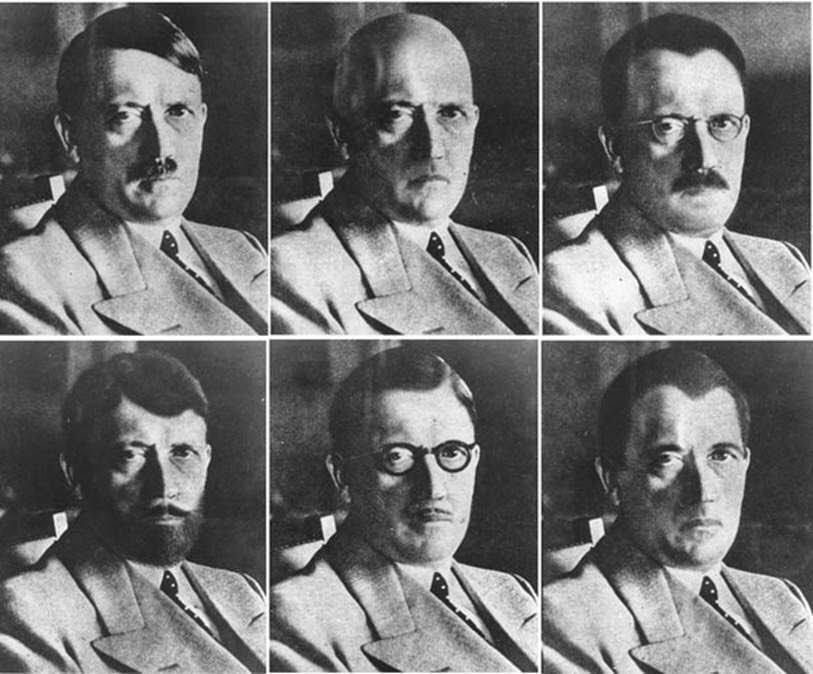 US intelligence images of how Hitler could have disguised himself if he had actually escaped, 1940s. Towards the end of World War II, U.S. intelligence officials were afraid that the German dictator would flee Germany by assuming a disguise. By 1944 the world identified the man largely by his trademark toothbrush mustache and oily side-slicked hair, so they ordered his portrait to be cloned. The Office of Strategic Services (OSS), an early version of the CIA set up during World War II, asked Eddie Senz, a New York make-up artist, to produce the altered portraits after D-Day on 6 June 1944. Despite fears Hitler would attempt to flee Germany, the portraits were never needed. However, photos of Senz’s re-imaginings of Hitler were circulated to Allied Commanders during the War but were not seen by the public until German magazine, Der Spiegel, discovered and published them in the 1990s. Later the U.S. National Archives in Washington DC released the photos with much better resolution. The following pictures show head shots of ‘Der Fuehrer’ in numerous guises.
US intelligence images of how Hitler could have disguised himself if he had actually escaped, 1940s. Towards the end of World War II, U.S. intelligence officials were afraid that the German dictator would flee Germany by assuming a disguise. By 1944 the world identified the man largely by his trademark toothbrush mustache and oily side-slicked hair, so they ordered his portrait to be cloned. The Office of Strategic Services (OSS), an early version of the CIA set up during World War II, asked Eddie Senz, a New York make-up artist, to produce the altered portraits after D-Day on 6 June 1944. Despite fears Hitler would attempt to flee Germany, the portraits were never needed. However, photos of Senz’s re-imaginings of Hitler were circulated to Allied Commanders during the War but were not seen by the public until German magazine, Der Spiegel, discovered and published them in the 1990s. Later the U.S. National Archives in Washington DC released the photos with much better resolution. The following pictures show head shots of ‘Der Fuehrer’ in numerous guises. -
8.
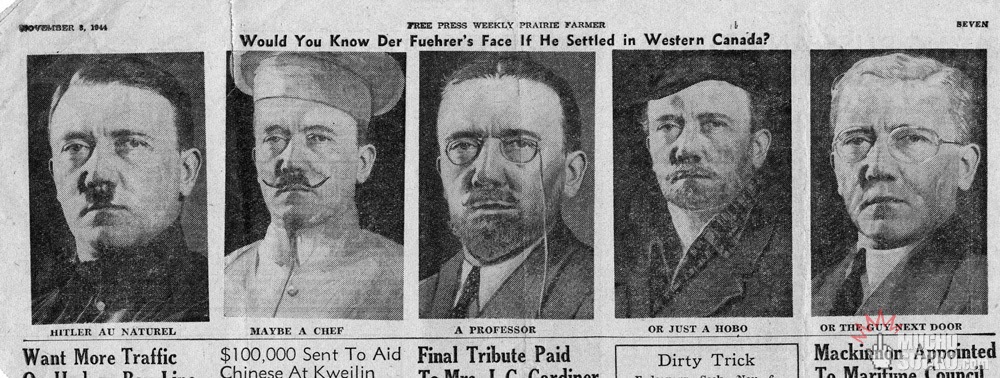 On November, 1944, a Canadian newspaper published some mock-ups of Hitler designed by a Canadian artist. The header for the mock-ups was: “Would you know Der Fuehrer’s face if he settled in Western Canada?”
On November, 1944, a Canadian newspaper published some mock-ups of Hitler designed by a Canadian artist. The header for the mock-ups was: “Would you know Der Fuehrer’s face if he settled in Western Canada?” -
9.
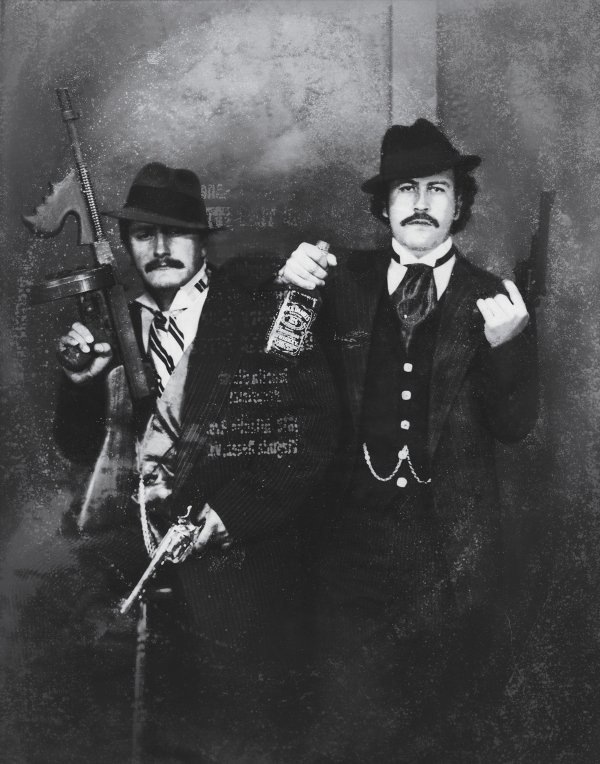 Pablo Escobar posing as a gangster with his cousin Gustavo in the 1980’s
Pablo Escobar posing as a gangster with his cousin Gustavo in the 1980’s -
10.
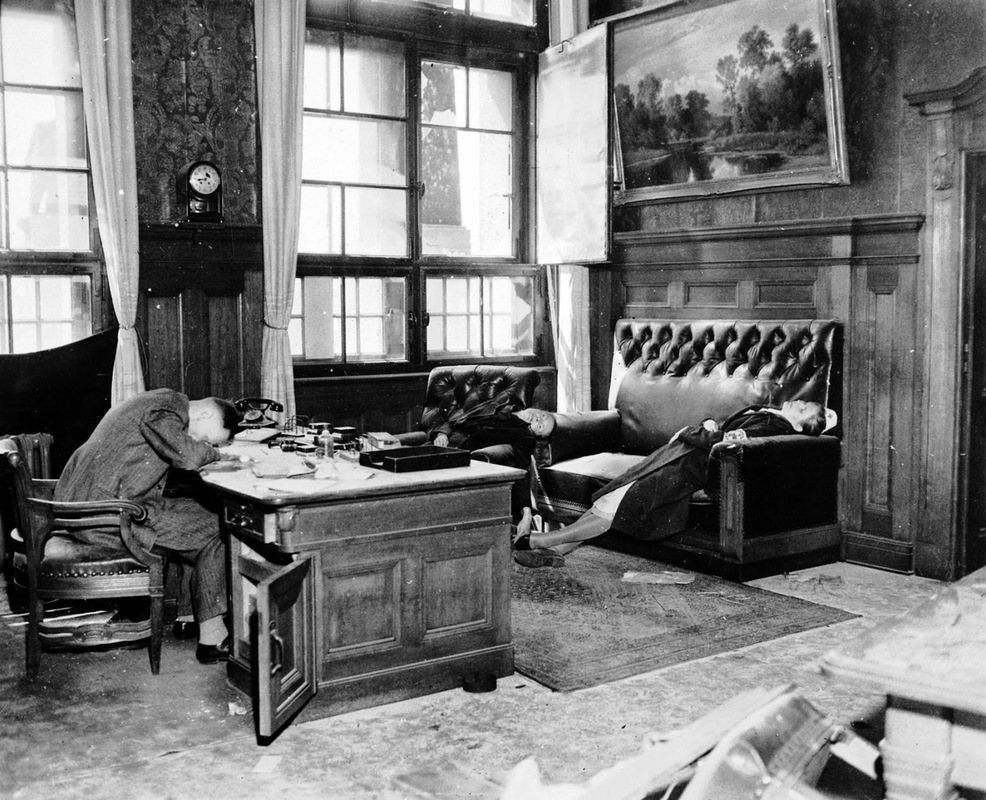 Deputy Mayor Ernst Kurt Lisso and his family after committing suicide by cyanide to avoid capture by US troops, 1945. As the Red Army and the Western Allies pressed closer and closer to Berlin suicides grew. Thousands of Germans committed suicide in the spring of 1945, rather than face occupation and the expected abuse by their victors. 3,881 people were recorded as committing suicide during April in the Battle of Berlin, although the figure is probably an underestimate. Although the motives was widely explained as the “fear of the Russian invasion”, the suicides also happened in the areas liberated by the British and American troops. On the 18th April 1945 a number of officials of Leizig committed suicide in the New Town Hall (Neues Rathaus). The Deputy Mayor of Leipzig Ernst Lisso decided to end his life but also that of his wife and daughter as the Americans press towards the city hall. In the death tableaux his wife Renate Lisso sits across from her husband and most shockingly his daughter Regina sits on the bench. She has an armband on and presumably was part of the German Red Cross aiding German soldiers before her premature death. In another room, the mayor and his wife and daughter similarly killed themselves before the Allied forces could do their worst. In both cases they used cyanide capsules.
Deputy Mayor Ernst Kurt Lisso and his family after committing suicide by cyanide to avoid capture by US troops, 1945. As the Red Army and the Western Allies pressed closer and closer to Berlin suicides grew. Thousands of Germans committed suicide in the spring of 1945, rather than face occupation and the expected abuse by their victors. 3,881 people were recorded as committing suicide during April in the Battle of Berlin, although the figure is probably an underestimate. Although the motives was widely explained as the “fear of the Russian invasion”, the suicides also happened in the areas liberated by the British and American troops. On the 18th April 1945 a number of officials of Leizig committed suicide in the New Town Hall (Neues Rathaus). The Deputy Mayor of Leipzig Ernst Lisso decided to end his life but also that of his wife and daughter as the Americans press towards the city hall. In the death tableaux his wife Renate Lisso sits across from her husband and most shockingly his daughter Regina sits on the bench. She has an armband on and presumably was part of the German Red Cross aiding German soldiers before her premature death. In another room, the mayor and his wife and daughter similarly killed themselves before the Allied forces could do their worst. In both cases they used cyanide capsules. -
11.
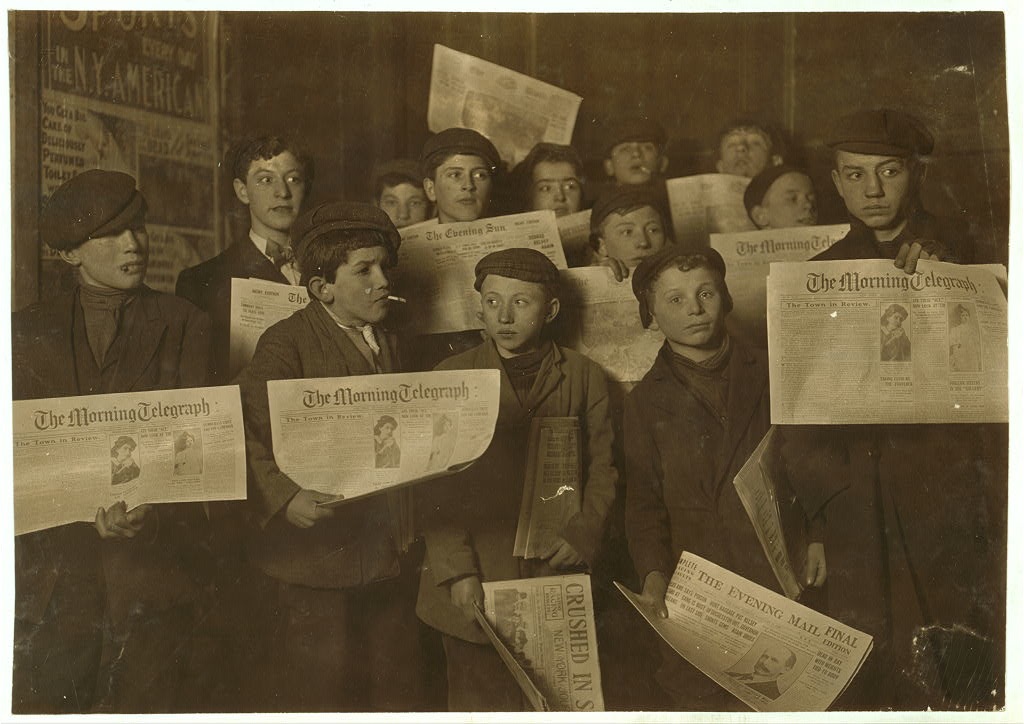 Paper boys at 2 A.M. about to start their morning rounds. February 12, 1908
Paper boys at 2 A.M. about to start their morning rounds. February 12, 1908 -
12.
 Reception Desk at General Motors Technical Center, 1965
Reception Desk at General Motors Technical Center, 1965 -
13.
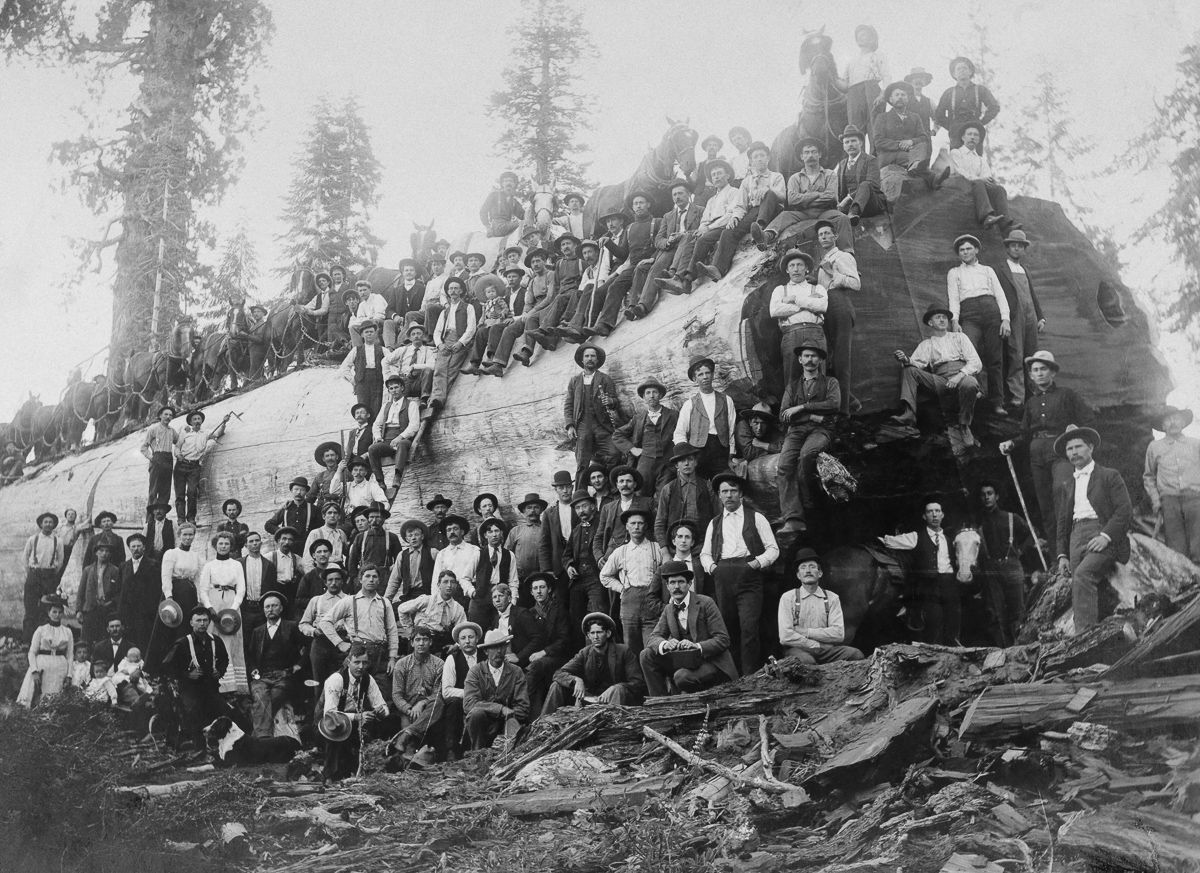 Over 100 people stand with a logged giant sequoia tree in California, 1917. The rough age of a tree this size is 2,500 years old. To put that in perspective, its older than christianity.
Over 100 people stand with a logged giant sequoia tree in California, 1917. The rough age of a tree this size is 2,500 years old. To put that in perspective, its older than christianity. -
14.
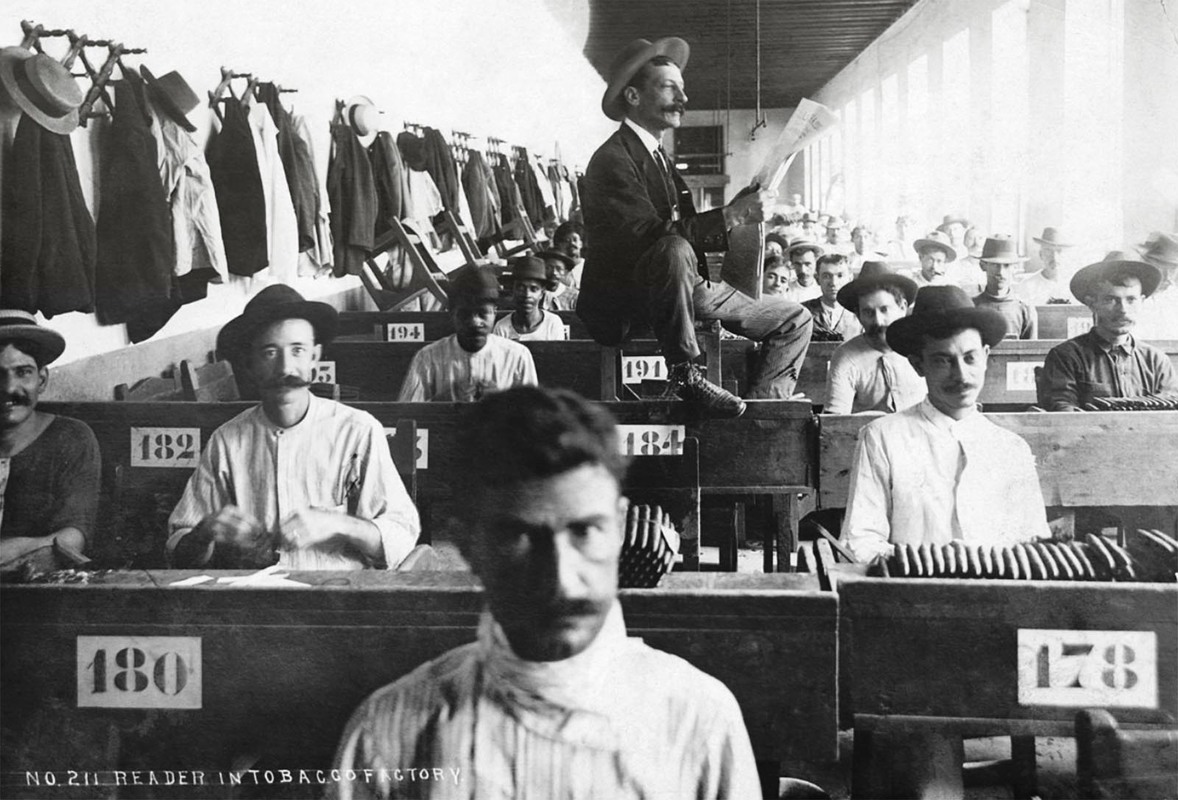 Tobacco factory Lectors, 1910. The practice of reading aloud while others listen intently as they engage in manual labor has a long and distinguished tradition through out the Caribbean in the practice of cigar manufacture. Because the job of rolling cigar after cigar could become monotonous, the workers wanted something to occupy and stimulate the mind. Thus arose the tradition of lectors, who sat perched on an elevated platform in the cigar factory, reading to the workers. It started in Cuba and was brought to the United States more particularly to Key West in 1865 when thousands of Cuban cigar workers emigrated to Florida to escape Spanish oppression. Historically, lectors or readers in a cigar factory entertained workers by reading books or newspapers aloud, often left-wing publications, paid for by unions or by workers pooling their money. The workers would each give 25 to 50 cents of their weekly salary to elect a fellow workman to act as “the reader” in which he would read aloud not just only newspapers, but even classical works of literature such as Tolstoy or Dickens. The readers, elected by their peers, were actually marvelous actors and would not simply read the book but literally act out the scenes in a dramatic fashion upon a podium set up in the middle of the factory. Workers were both generous and ruthless to the lectors, depending on the performance. If they enjoyed the day’s reading, they would loudly tap their chavetas on their cutting boards as a form of applause. On the other end of the spectrum, workers could vocalize their unhappiness with a particular reading. Since the lector was paid by the workers, he or she took cues from them. The lector committee, not the lector, chose the materials to be read. This mattered very little to the factory owners. The lectors were forced out of the factories when what they were reading was deemed too radical. This caused widespread strikes and work slowdowns.
Tobacco factory Lectors, 1910. The practice of reading aloud while others listen intently as they engage in manual labor has a long and distinguished tradition through out the Caribbean in the practice of cigar manufacture. Because the job of rolling cigar after cigar could become monotonous, the workers wanted something to occupy and stimulate the mind. Thus arose the tradition of lectors, who sat perched on an elevated platform in the cigar factory, reading to the workers. It started in Cuba and was brought to the United States more particularly to Key West in 1865 when thousands of Cuban cigar workers emigrated to Florida to escape Spanish oppression. Historically, lectors or readers in a cigar factory entertained workers by reading books or newspapers aloud, often left-wing publications, paid for by unions or by workers pooling their money. The workers would each give 25 to 50 cents of their weekly salary to elect a fellow workman to act as “the reader” in which he would read aloud not just only newspapers, but even classical works of literature such as Tolstoy or Dickens. The readers, elected by their peers, were actually marvelous actors and would not simply read the book but literally act out the scenes in a dramatic fashion upon a podium set up in the middle of the factory. Workers were both generous and ruthless to the lectors, depending on the performance. If they enjoyed the day’s reading, they would loudly tap their chavetas on their cutting boards as a form of applause. On the other end of the spectrum, workers could vocalize their unhappiness with a particular reading. Since the lector was paid by the workers, he or she took cues from them. The lector committee, not the lector, chose the materials to be read. This mattered very little to the factory owners. The lectors were forced out of the factories when what they were reading was deemed too radical. This caused widespread strikes and work slowdowns. -
15.
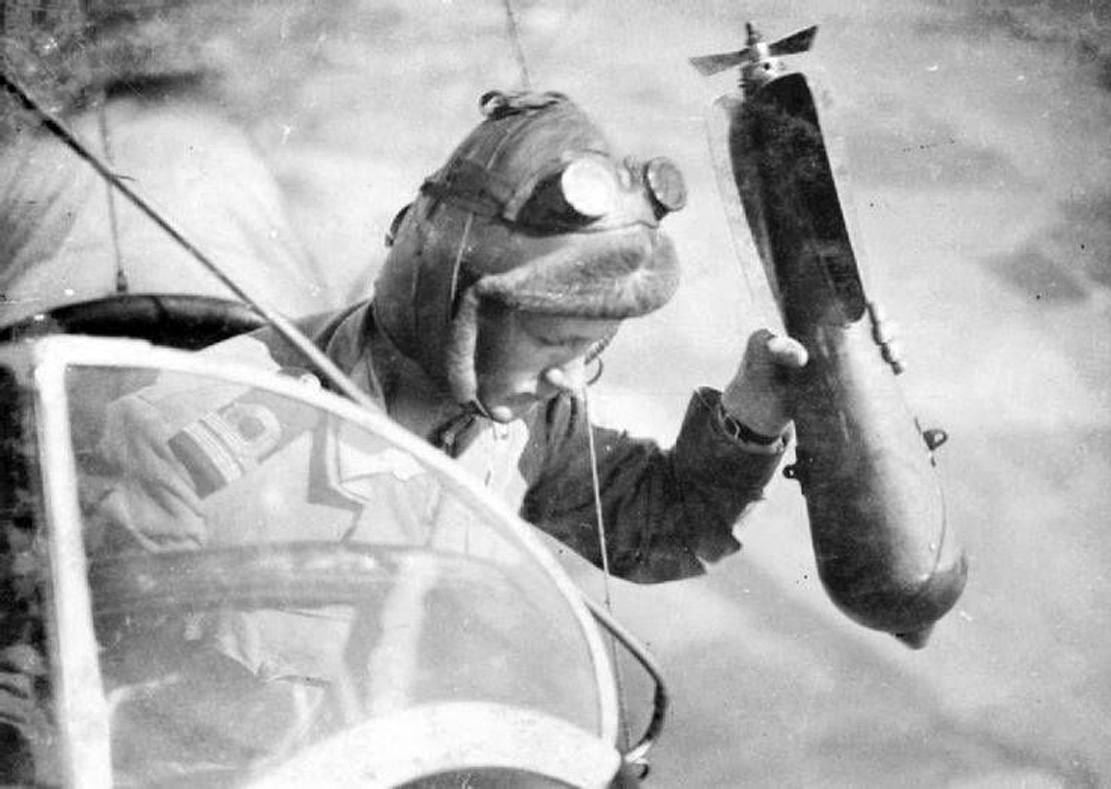 An english military aviator dropping a bomb during a flight on the French front during World War 1, c. 1916
An english military aviator dropping a bomb during a flight on the French front during World War 1, c. 1916 -
16.
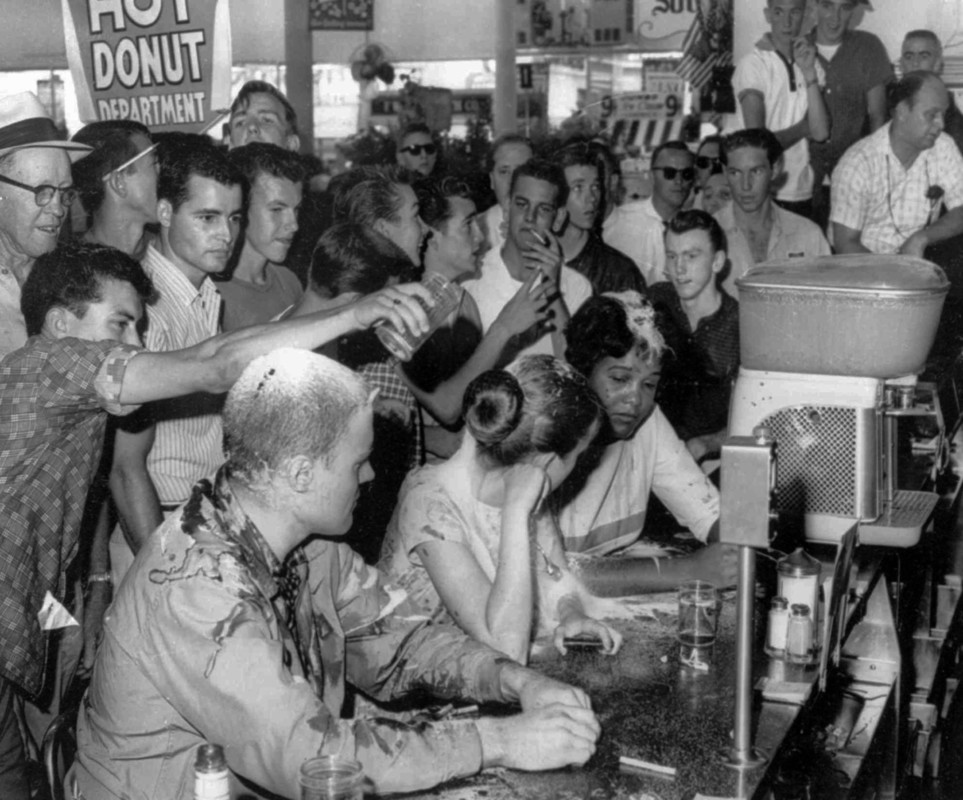 Sit-in demonstration at a Woolworth’s whites-only lunch counter in Jackson, Mississippi, turned violent when a mob poured sugar, ketchup and mustard over the heads of demonstrators, from left, John Salter, Joan Trumpauer and Anne Moody. May 28, 1963
Sit-in demonstration at a Woolworth’s whites-only lunch counter in Jackson, Mississippi, turned violent when a mob poured sugar, ketchup and mustard over the heads of demonstrators, from left, John Salter, Joan Trumpauer and Anne Moody. May 28, 1963 -
17.
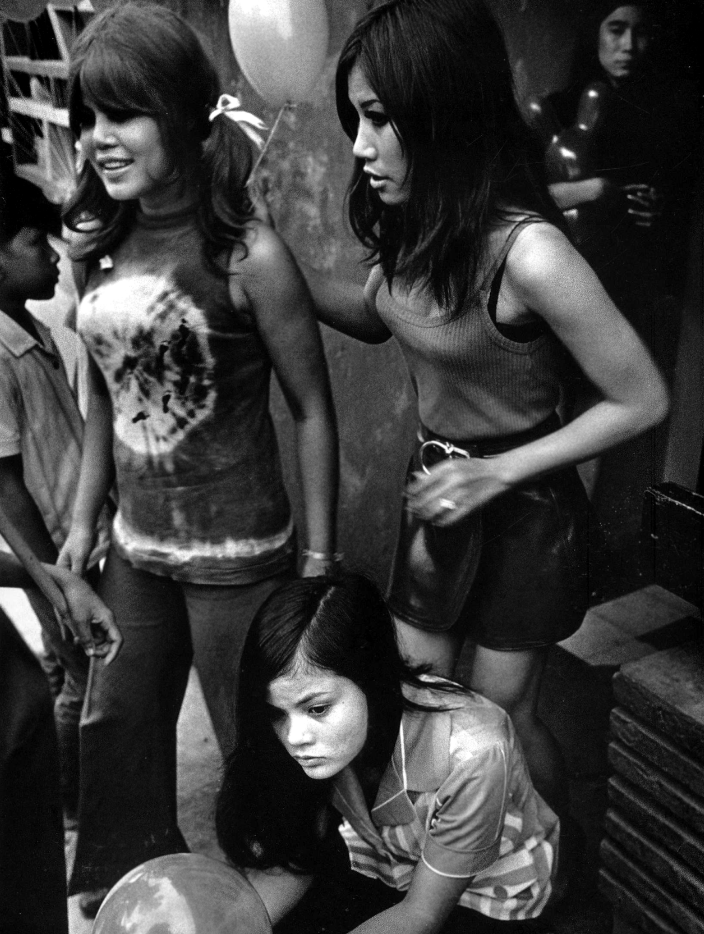 Prostitutes in Can Tho, Vietnam, 1970 by Philip Jones Griffith
Prostitutes in Can Tho, Vietnam, 1970 by Philip Jones Griffith -
18.
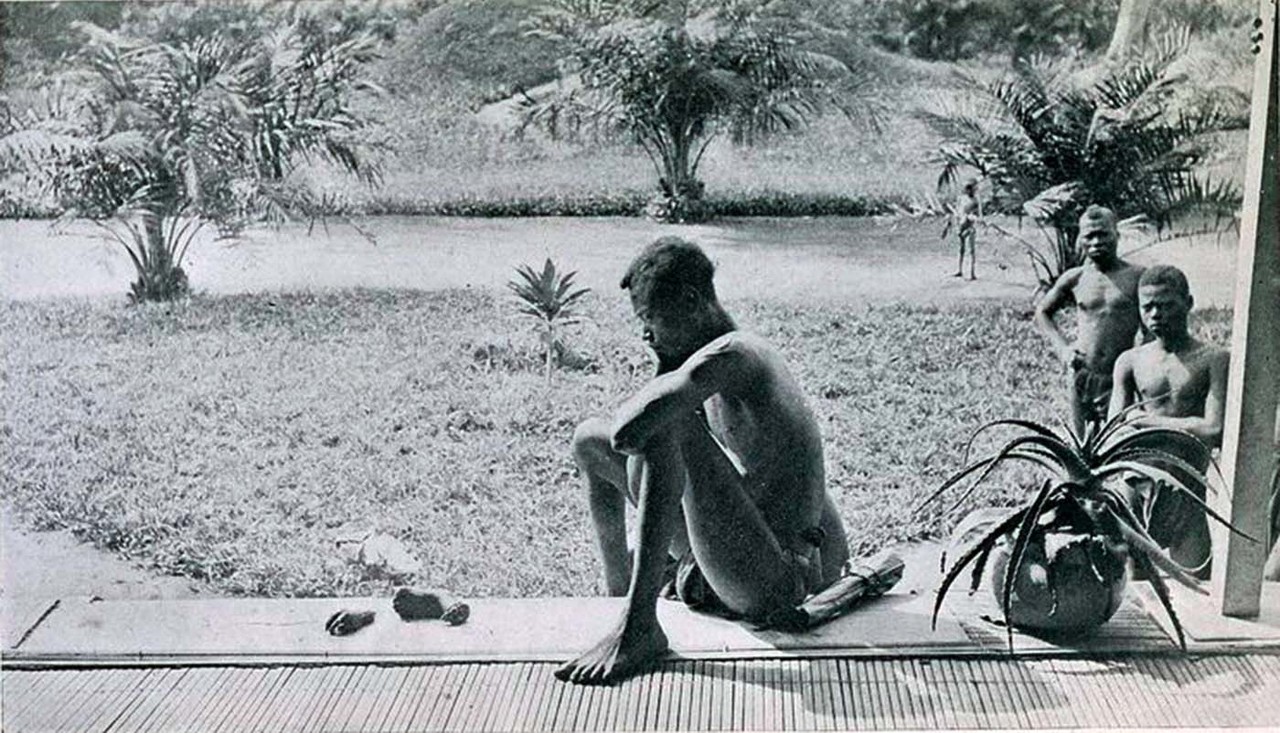 Father stares at the hand and foot of his five-year-old, severed as a punishment for failing to make the daily rubber quota, Belgian Congo, 1904. He hadn’t made his rubber quota for the day so the Belgian-appointed overseers had cut off his daughter’s hand and foot. Her name was Boali. She was five years old. Then they killed her. But they weren’t finished. Then they killed his wife too. And because that didn’t seem quite cruel enough, quite strong enough to make their case, they cannibalized both Boali and her mother. And they presented Nsala with the tokens, the leftovers from the once living body of his darling child whom he so loved. His life was destroyed. They had partially destroyed it anyway by forcing his servitude but this act finished it for him. All of this filth had occurred because one man, one man who lived thousands of miles across the sea, one man who couldn’t get rich enough, had decreed that this land was his and that these people should serve his own greed. Leopold had not given any thought to the idea that these African children, these men and women, were our fully human brothers, created equally by the same Hand that had created his own lineage of European Royalty.
Father stares at the hand and foot of his five-year-old, severed as a punishment for failing to make the daily rubber quota, Belgian Congo, 1904. He hadn’t made his rubber quota for the day so the Belgian-appointed overseers had cut off his daughter’s hand and foot. Her name was Boali. She was five years old. Then they killed her. But they weren’t finished. Then they killed his wife too. And because that didn’t seem quite cruel enough, quite strong enough to make their case, they cannibalized both Boali and her mother. And they presented Nsala with the tokens, the leftovers from the once living body of his darling child whom he so loved. His life was destroyed. They had partially destroyed it anyway by forcing his servitude but this act finished it for him. All of this filth had occurred because one man, one man who lived thousands of miles across the sea, one man who couldn’t get rich enough, had decreed that this land was his and that these people should serve his own greed. Leopold had not given any thought to the idea that these African children, these men and women, were our fully human brothers, created equally by the same Hand that had created his own lineage of European Royalty.
- REPLAY GALLERY
-

- Interesting Collection of Photos Collected From History
Troops and crewmen aboard a Coast Guard manned LCVP get ready to storm the Normandy beaches. June 6th, 1944
18/18
1/18
Categories:
Wow


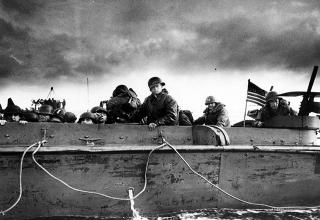





3 Comments